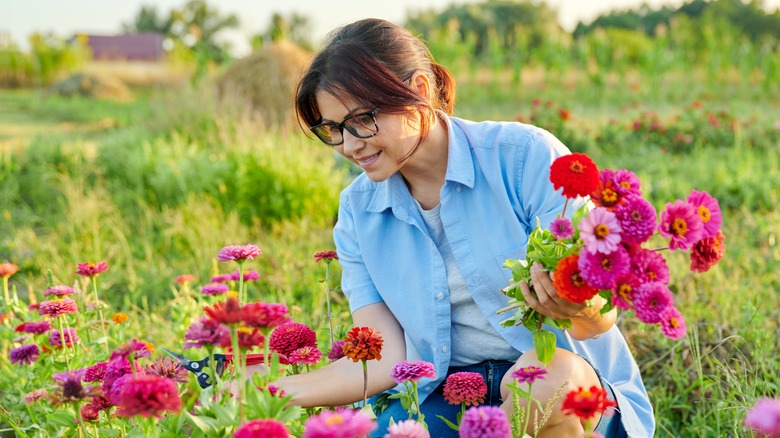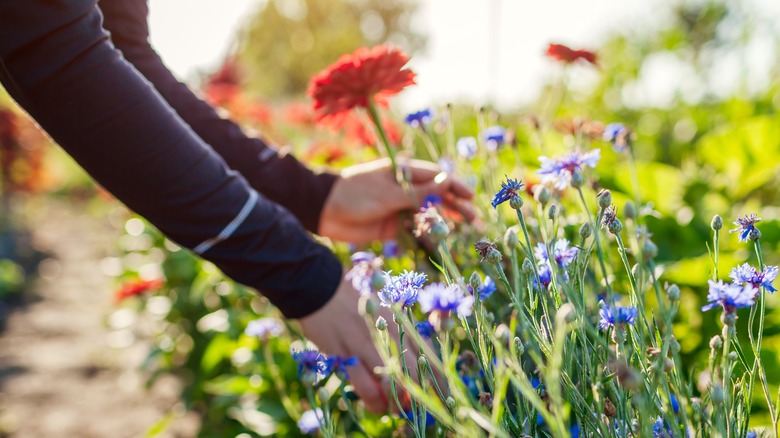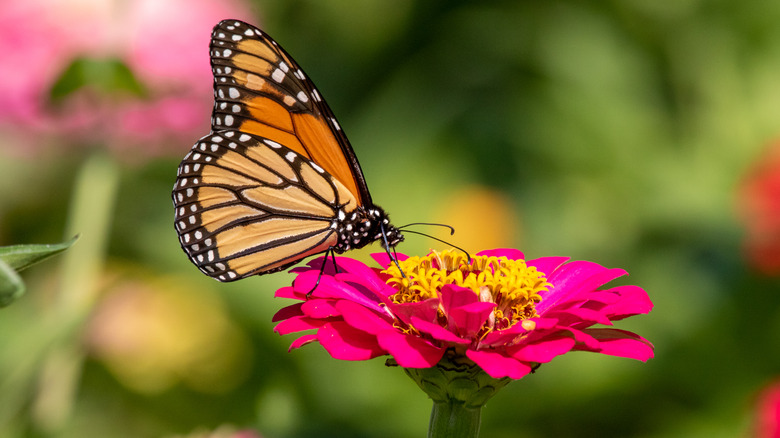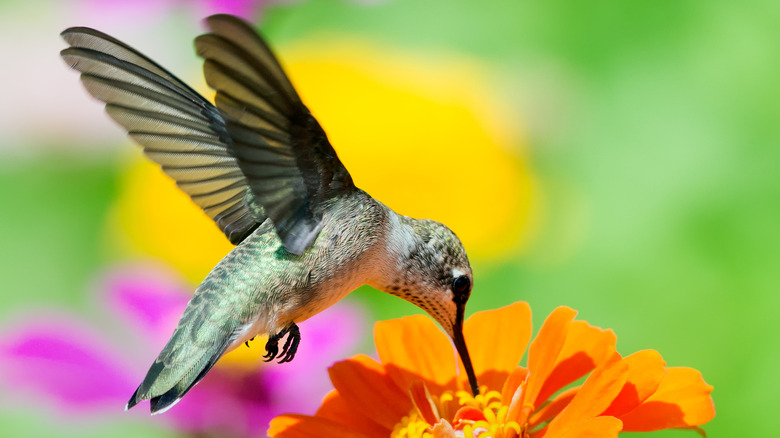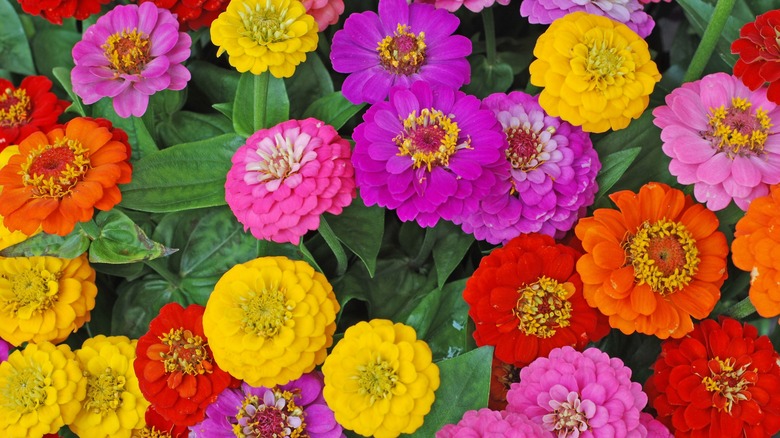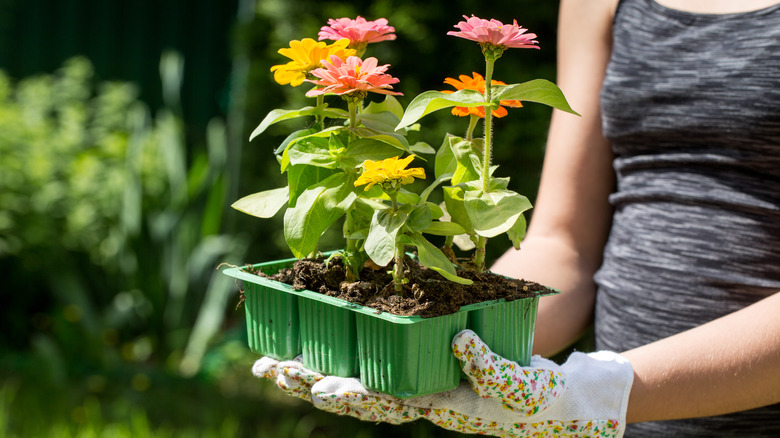How To Grow And Care For Zinnias
If one flower can fool you into thinking you're looking at an entire garden, it's the zinnia (of the aster family, Asteraceae). Not only do they bloom in a dazzling array of colors, but their shapes vary widely, too. What's more, they're so self-sufficient that they make an ideal starter plant for a budding gardener — whether that's you or a younger member of the family. Still not impressed? They're also resistant to both drought and heat.
In fact, zinnias are often the workhorses of any flowerbed come summer, the Chicago Botanic Garden notes. By their assessment, there's hardly a flower in existence that can compete with its many attributes because, besides those already mentioned, some zinnias can zoom from seed to bloom in a mere matter of weeks. In addition, zinnias are annuals related to daisies, meaning they'll grow for a single season, producing seeds and flowers. Commonly, zinnias are identified as double, semi-double, or single and categorized according to whether the flower's center is visible and the configuration of their petals.
How to use zinnias in the garden
As you might expect, zinnias are so versatile, hearty, and colorful that their use in the garden is (almost) only limited by your imagination. In addition, they grow at various heights — some as short as 6 to 12 inches and others reaching up to 4 feet. So the taller ones can be grown at the back of a garden bed and still be visible, while the shorter ones are often ideal for creating borders. Zinnias also attract an assortment of beneficial insects like bees and offer an irresistible treat to hummingbirds and butterflies.
Gardeners Path says it's commonly agreed that zinnias originated in Mexico and were probably being cultivated by the Aztecs as far back as the 1500s. Because their little arrowhead-shaped seeds simply drop off and they're so adaptable, they often repopulate without any effort whatsoever, giving you time to tend to other concerns in the garden or elsewhere. Moreover, they'll last for the better part of a week once cut if properly cared for, and they're edible (although they don't have much flavor), so you can put them to use in your garden, potted inside, displayed in a vase, or plate them next to your favorite dish for a splash of color. This also means they aren't toxic to humans, pets, or animals.
How to grow zinnias
Ask the gardeners at Almanac, and they'll tell you that zinnias can thrive with almost no intervention. You can nudge nature along by planting your flowers in a spot that gets between six and eight hours of sunlight a day with a good amount of circulating air in soil that's pH balanced somewhere between 7.5 and 5.5. If you're planting in the ground and don't know the composition of what's underfoot, an internet search can quickly identify places to submit a soil sample and get a complete breakdown for very little money.
Zinnias grow quickly and easily from seed in both containers and garden beds. But there are two things they don't like: frost and transplantation. So don't start them until the weather warms, and if you must transplant them, do so early and with extra care. Otherwise, you can practically watch them grow overnight. Depending on the size of your zinnias, you'll want to sow your seeds in shallow soil between 4 and 24 inches away from each other in temperatures that range from 60°F to 85°F. Let the seller's instructions be your guide. Most times, you'll see seedlings in less than a week. Once they reach a height of 3 inches, you may wish to thin your cache so that they're far enough apart to get the best circulation of air. Full sunlight works best with moderate watering because seedlings often rot in soil that's too cool or wet.
How to care for zinnias
For advice on caring for your zinnias, look no further than Martha Stewart. Her site recommends watering roughly three times each week to the point where moisture penetrates between 6 and 8 inches into the soil. However, remember that less is more when it comes to zinnias because they do better dry than too wet. The evidence of overwatering will be quickly visible: You'll see signs of rot, leaf spots, and mildew that looks powdery. If you're growing zinnias in a container, water them when the soil feels dry to the touch — and try not to get water on the leaves because that can lead to fungus trouble.
You may also wish to mulch because compost and fertilizers can aid in making your zinnias perform at their peak. You'll want to wait until your plant has a healthy start, then mulch with 2 inches of bark or straw to help keep the soil moist and inhibit any weeds. An organic fertilizer will yield more and larger blossoms at the flowering time as well. Lastly, be fearless in pruning. Once your zinnias are well underway, the more often you prune, the more the plant rededicates new growth to branches and flowers. You can also find yourself doing less deadheading (cutting flowers away after they're well past bloom) if you cut them while they're at the peak and place them in vases around the house. Remember, too, that these flowers love full sunlight.
Varieties of zinnias
Home Stratosphere identifies more than 20 species of zinnias, 10 of which make up garden flowers, and the most popular among those is called Zinnia Elegans. These plants have been tinkered with for centuries by horticulturists who can't seem to find any end to their capacity for successful mutation. As mentioned, they range wildly in size, too — from miniature to 3 and 4 feet tall. Zinnias are categorized according to the rows of their petals because when it comes to color, they appear in white and nearly every other hue of the rainbow — except blue.
Botanists break down the four major types of zinnias like this:
• Cactus Flowered: These are long flowers, with each petal curling to the underside to form a flower that, almost like a snowflake, has a unique pattern.
• Single Flowered: These zinnias are easily recognized by their exposed center and a single row of petals.
• Semi-Double Flowered: The center of these flowers is plainly on display, but there are multiple petal rows.
• Fully Double Flowered: These have no visible center because multiple petal rows obscure the area.
How to repot zinnias
Being annual flowers, zinnias don't need dividing. And being so easy to grow from seeds, most prefer to simply plant anew or let the seeds that drop off this season's zinnias do the work. But for some gardeners (and depending on the variety of zinnia), the impulse or need to transplant can arise. Naturally, zinnias don't like to be disturbed on their life's journey, but if you must, according to Do It Yourself, have a larger container so that you don't have to repeat your steps later.
It's a process you'll want to undertake in the morning. Start with a big enough hole to accommodate not only the plant but also its rootball and whatever soil is clinging to your zinnias. You want to cause as little disruption as possible. Make sure the top of your rootball is 0.5 inches to 1 inch below ground at planting. Add soil, but don't pack it too firmly (which can damage the roots), then water. Finally, repeat that watering at the end of the day.
